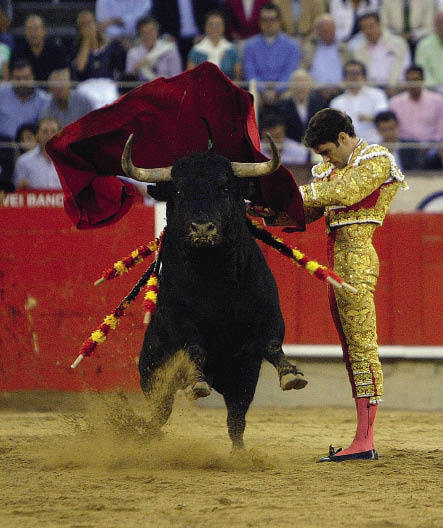In these days of growing concern at the methods of factory farming and the welfare of the animals which are raised and killed for our consumption, it is instructive to compare the life of domestic beef cattle with that of a Spanish fighting bull. The cattle may have less than two years of life in cramped conditions, while the toro bravo roams free and unmolested on pasture for five years. Alexander Fiske- Harrison makes the comparison succinctly: ‘Five years on free-release and then the arena, or 18 months in prison and then the electric chair’. He maintains (there is some evidence for this, to do with beta-endorphins) that the fighting bull’s suffering is reduced because, once in the ring, it feels no fear, only aggressive anger. Ban the bullfight and this magnificent breed of animal would cease to exist. It is not a good converter of grass into protein, and anyway far too dangerous to be bred only for meat and milk.
The case for what in Spain is called la corrida de toros is well made in this entertaining account of two years which the author spent in Andalusia — following the bulls, caping young cows himself, getting to know a few matadors, attending ferias and flamenco parties. An initially reluctant convert to this Spanish cultural tradition, he comes to accept that ‘part of the justification of the suffering is the art’. When- ever he sees a bad and bloody corrida, however, his doubts over the cruelty surface again. Every aficionado has seen fights which are both shameful and plain boring. But when everything goes right, the spectacle can be absorbing, uplifting, even emotional.
What Fiske-Harrison seeks, as someone wrote of the great torero Antonio Ordoñez, is ‘a demonstration of the values which distinguish bullfighting from butchery’. Those values are concerned with technique, artistry, grace under pressure from a highly dangerous animal which is doing its best to kill its adversaries. In conversation with one of Ordoñez’s matador grandsons, Cayetano, the author learns of ‘the warmth a great bull could inspire in him, of his sadness at killing’.
Having returned to Oxford and read a few books on animal rights, he decides, for reasons not entirely clear, that he must go back to Spain and kill a bull himself. Coached by a former matador, Dávila Miura (who is absurdly described as ‘one of the greatest matadors of all’ — in a short career most of his successes were achieved in third-class rings), Fiske-Harrison proves himself brave and competent enough to reach what the Spanish call la hora de la verdad, the moment of truth, when he puts his bull to the sword and gains some understanding of what Cayetano had told him.
The disappointment of this book is that it has more about the author than ‘the world of the Spanish bullfight’. He might have considered the significance of religion — almost all bullfighting ferias are held in honour of a saint, or a festival such as Pentecost or Corpus Christi — the effect of the economic recession on the future of la fiesta brava, and of the ban in Catalonia (probably minimal: the encouraging response of the socialist government in Madrid was to hand over responsibility for bullfighting to the Ministry of Culture). He might also have discussed the ever-growing popularity of the corrida in south-west France, where it is conducted precisely as in Spain, and exploded the myth that bullfighting survives for the entertainment of foreign tourists. (When I attended a fight last summer in Malaga — the centre of tourism on the Costa del Sol — with a capacity audience of 12,000, I saw no foreigners there, nor heard a word of English spoken.)
Among the principal toreros of today, Fiske-Harrison gives only brief mention to the two — Enrique Ponce and El Juli — who have dominated the scene for the past decade, and the faintest praise to José Maria Manzanares, who has emerged recently as both a consummate artist and master swordsman. One of the book’s best passages — which bears comparison with Kenneth Tynan’s outstanding book, Bull Fever — is the description of a performance by the controversial José Tomás in Jerez. This so-called phenomenon, or suicidal lunatic, having lost 17 pints of blood from a horrible goring in Aguascalientes, Mexico last year, is due to make his comeback in Valencia next month.






Comments